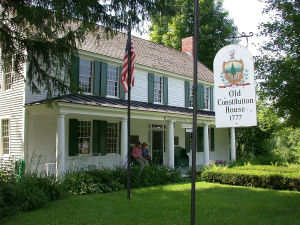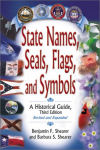
HOME
INTRO
SYMBOLS
ALMANAC
ECONOMY
GEOGRAPHY
STATE MAPS
PEOPLE
FORUM
NEWS
COOL SCHOOLS
STATE QUIZ
STATE LINKS
BOOK STORE
MARKETPLACE
GUESTBOOK
CONTACT US


Tweet
Double click on word for definition.
Vermont State Motto
Translation: Origin: Ira Allen's 1779 Vermont seal Adopted: February 20, 1779
What is a motto?
Merriam-Webster Online defines motto in this way:
Main Entry: mot·to
Pronunciation: 'mä-(")tO
Function: noun
Inflected Form(s): plural mottoes also mottos
Etymology: Italian, from Late Latin muttum grunt, from Latin muttire to mutter
1 : a sentence, phrase, or word inscribed on something as appropriate to or indicative of its character or use
2 : a short expression of a guiding principle
State mottoes may be said to reflect the character and beliefs of the citizens of the state, or more accurately, the citizens of the state when they were adopted. State mottoes can often help us gain insight into the history of a state.
Adoption of the Vermont State Motto
Vermont's state motto was adopted as an element of its official state seal.
From 1749 to 1764 the royal governor of New Hampshire, Benning Wentworth, made land grants on lands claimed by New Hampshire west of the Connecticut River. Unfortunately, this land was also claimed by New York. In 1764, the king stepped in to resolve the resultant disputes. He gave the rights to the land to New York.
As one can imagine, disagreement between holders of New York grants and New Hampshire grants on a local level were not so easily resolved.
The disputed land was most commonly known as the New Hampshire Grants and Ethan Allen and his local militia, the Green Mountain Boys, supported the claims made by New Hampshire.
In 1776, the Declaration of Independence declared the colonies independent of its former benefactor, Great Britain.
As in the colonies, the people in the New Hampshire Land Grants were divided in their loyalties.

Elijah West's Windsor Tavern
Called "The Old Constitution House" today
Confounded by the dispute between New York and New Hampshire and between the Colonies and Great Britain, , Ethan Allen's Green Mountain Boys set about suppressing loyalists. In January 1777, delegates from 28 towns between the Connecticut River and New York met and declared the New Hampshire Grants independent from Great Britain. Initially the new entity was called The Republic of New Connecticut but was changed to Vermont later in the year.
A constitution was drafted, then adopted on July 8, 1777, at Elijah West's Windsor Tavern, now known as the Old Constitution House. That new entity is today often referred to as the Vermont Republic (1777-1791).
In 1778, Ethan Allen's youngest brother, Ira Allen, Green Mountain Boy, Revolutionary War soldier, statesman, political leader and soon to be "Father of the University of Vermont," designed a seal for the new entity. The seal was accepted by resolution of the Vermont General Assembly on February 20, 1779.
The seal was rather crude, but contained imagery representative of the Republic of New Connecticut.
This seal also contained the motto "Freedom and Unity." The motto is representative of its times, reflecting the national relationship with Great Britain and Vermont's rejection of New York jurisdiction. It highlights the ideal of balancing personal individual freedom with an individual's responsibility to their community. More practically, the motto reminds us to value our freedoms and also embrace our social responsibilities.
Sources...
Shankle, George Earlie. State Names, Flags, Seals, Songs, Birds, Flowers, and Other Symbols. Irvine, Calif.: Reprint Services Corp, Revised edition, 1971.
Shearer, Benjamin F. and Barbara S. State Names, Seals, Flags and Symbols: A Historical Guide Third Edition, Revised and Expanded. Westport, Conn: Greenwood Press, 3 Sub edition, 2001.
Additional Information
Stella quarta decima fulgea: Vermont's Latin motto from NETSTATE.COM.
State Motto List: Complete list of all of the state mottoes from NETSTATE.COM.

State Names, Seals
Flags and Symbols
Benjamin F. Shearer
Barbara S. Shearer
State Names, Seals, Flags and Symbols, by Benjamin F. Shearer, Barbara S. Shearer. 544 pages. Greenwood Press; 3 Sub edition (October 30, 2001) This is one of the best, and most comprehensive, books we could find about the official state names and nicknames, mottoes, seals, flags, capitols, flowers, trees, birds, songs, and miscellaneous designations of each state. This, coupled with the 1938 Shankle book, formed the basis of our symbol library. If you're serious about your states symbols, you'll want to have this book and the one below. This book also contains information about state holidays, license plates, sports teams, universities and other trivia.
State Names, Flags, Seals, Songs, Birds, Flowers, and Other Symbols, by George Earlie Shankle. 522 pages. Reprint Services Corp; Revised edition (June 1971) Reprint of the 1938 revised edition. The first comprehensive book about our state symbols! From the preface: "This book grew out of the desire of its author to know, about his native state, a great many facts which he found exceedingly difficult to obtain. After three years of research in the Library of Congress, he is able to give to the public this storehouse of information, which could have been gathered from not library less fertile in source material..."
Visit the NETSTATE Vermont State Book Store for additional Vermont related books, including Vermont Reference Books, History, Biographies and Cookbooks.



